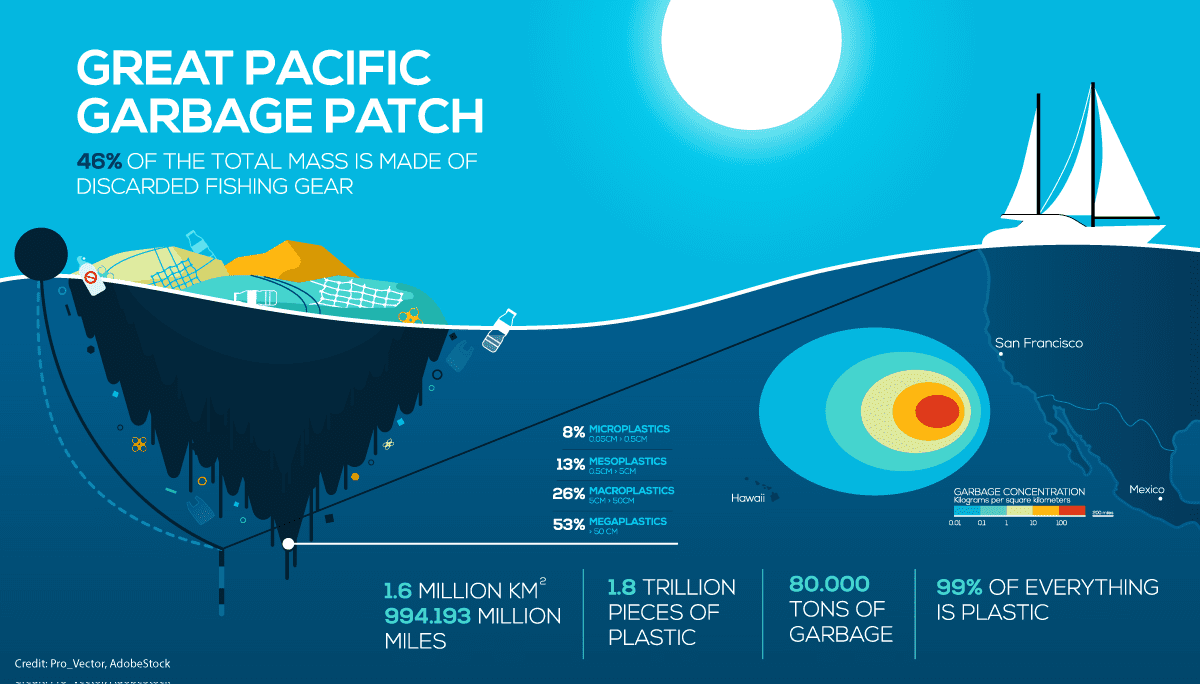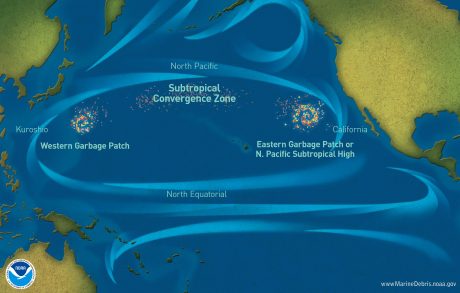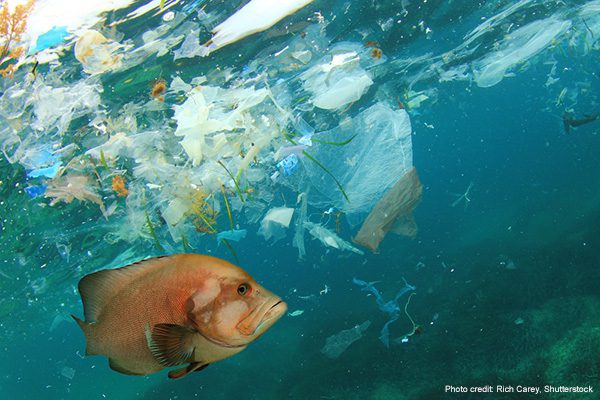
May 02, 2023 Plastic Waste and the World’s Seas
Fifty years ago (Feb 10, 1973), Science News published a short article, “Setting sail into a plastic sea.” The story noted that scientists on an oceanographic voyage in the North Pacific “recorded 53 manmade objects in 8.2 hours of viewing” even though “they were 600 miles from Hawaii and far off major shipping lanes. In 1997, twenty-four years later, the Pacific garbage patch was “rediscovered” by Charles Moore who was returning from a trans-Pacific yacht race. He found himself in the ocean surrounded by plastic bobbing in the waves as far as he could see.

Credit: NOAA
Fifty years later, major “ocean garbage patches” full of plastic waste have been identified in the Pacific (2), Atlantic (2), and Indian (1) oceans. These ocean garbage patches are created by ocean currents that form gyres (giant whirlpools) that concentrate marine debris into specific areas in the ocean.
Many people have heard of the North Pacific garbage patch (the “Great Pacific Garbage Patch”). This “patch” consists predominantly of two areas on either side of the northern Pacific Ocean where ocean currents concentrate marine debris into Texas-sized areas in the ocean. The term “garbage patch” evokes an image of a pile of debris floating on the ocean surface, creating an island of plastic. While large objects are floating in these garbage patches (discarded fishing gear comprises more than 50% of the debris by weight), a significant portion of ocean plastic debris consists of microplastics (particles less than a quarter inch in size) that are distributed throughout the ocean (and in freshwater lakes). In the “garbage patches,” the microplastics create a soup of tiny particles that extend through the water column. Microplastics may come from the tiny plastic beads added to cosmetics and facial cleaners but are also derived from larger plastic objects when broken down into smaller pieces by the sun and waves. In addition, plastic microfibers are released from clothing and fishing nets. The sea floor under the “garbage patch” may also have an underwater trash heap when marine debris sinks to the seabed.
 There is widespread concern over the potential impact of microplastics on ecosystems and animal (including human) health. However, actual data on the health effects of microplastics are scarce. A recent paper by scientists at the Virginia Institute of Marine Science documents the varying impact of different microplastics on the health of rainbow trout infected with the Infectious Hematopoietic Necrosis Virus (IHNV). IHNV is a serious problem in salmon and trout aquaculture but also infects wild salmonids. The virus was first reported in fish hatcheries in Oregon and Washington in the 1950s but has now spread worldwide.
There is widespread concern over the potential impact of microplastics on ecosystems and animal (including human) health. However, actual data on the health effects of microplastics are scarce. A recent paper by scientists at the Virginia Institute of Marine Science documents the varying impact of different microplastics on the health of rainbow trout infected with the Infectious Hematopoietic Necrosis Virus (IHNV). IHNV is a serious problem in salmon and trout aquaculture but also infects wild salmonids. The virus was first reported in fish hatcheries in Oregon and Washington in the 1950s but has now spread worldwide.
The project tested three different types of microplastics on the mortality of rainbow trout infected with IHNV. Fish were exposed to plastic breakdown products from polystyrene plastics (e.g., floats, buoys, food containers), nylon fibers (from fishing gear and clothing), and natural fragments of the common saltmarsh cordgrass (Spartina alterniflora). IHNV was then added to half the tanks. Fish mortality from the virus alone was around 20%. In the presence of the virus and natural particles, mortality was about 30%; with the virus and polystyrene particles, mortality was approximately 45%; but mortality from the virus in the presence of nylon fibers was around 80%.
The research team speculated that exposure to microparticles increases virus disease severity because the microparticles might damage the delicate gill tissues, consequently providing more accessible routes of infection for the virus. The nylon fibers had the most severe impact. This may have been due to the larger size of the fibers or to the higher hardness of nylon compared to the cordgrass and polystyrene particles. The team also wondered about the impact of microplastics, ubiquitous in household dust, on the progression of airborne diseases such as Covid-19 in humans. The measurement of human microplastic exposure is still in the very early stages of development.
The increase in worldwide plastic manufacture and use from a few million tons in 1950 to 460 million tons in 2019 has led to the high levels of plastic pollution observed today, not just in aquatic ecosystems but also on land and in the homes and offices where people spend most of their time. Only 9% of global plastic waste is recycled. Plastic litter entering the environment doubled in the 21st century to 353 million tonnes. Addressing plastic waste effectively is a significant challenge. The OECD reports that 1.7 million tonnes of plastic waste enter the world’s oceans and seas annually, adding to the estimated 30 million tonnes already present in the marine environment (and the estimated 109 million tonnes currently present in freshwater lakes and rivers). Removing plastic waste is not now a practical or effective option.
The OECD has identified four levers to reduce and manage the plastic waste avalanche – namely, developing effective markets for recycled plastics, increasing technological innovations to implement a reliable, circular plastic economy, installing national domestic policies to address plastic production and waste prevention, and improved international cooperation including increased international financing.
When Mr. Maguire took Dustin Hoffman’s character aside in the 1967 movie The Graduate to pass on just one word – “Plastics,” he focused on the economic opportunities for a young graduate in the evolving plastics industry. Today, sadly, tackling and solving the ecological and health challenges of the plastics revolution will be a legacy left for many generations of new graduates.


